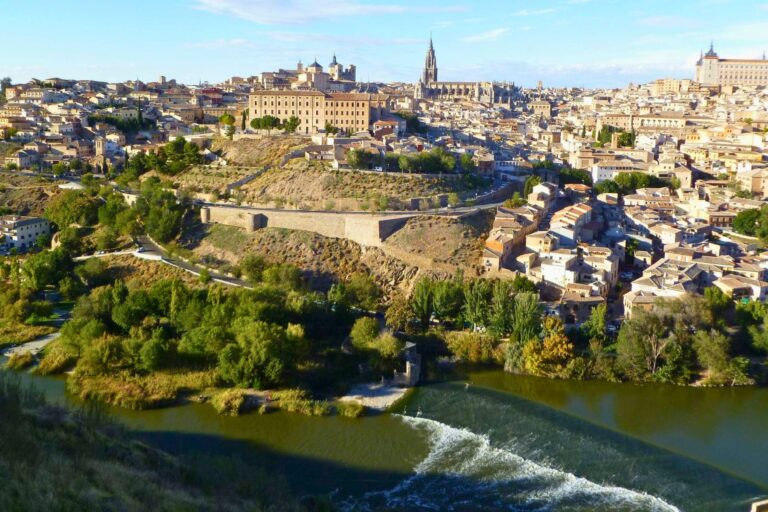
We are reader-supported and may earn a commission on purchases made through links in this article.
Visitors to Spain — and in fact much of Europe — are frequently dismayed nowadays to find the places they most want to see are thronged with tourists. Places like Barcelona, Madrid, and Seville, and even the coastal areas and Mediterranean islands can all be challenges to negotiate, depending on the season, because of the shoulder-to-shoulder masses of people that interfere with visitors’ enjoyment of these cultural highlights.
But I’m here to tell you of a magical place that’s still largely undiscovered and offers the very best of Spain without the crowds. It’s a large region called Extremadura (Go ahead and look it up — I had to!)
It’s located in western Spain between Madrid and the Portuguese border, just north of Seville and Andalusia. With picturesque medieval towns, plentiful Roman ruins, and a unique local cuisine that makes mealtimes unforgettable, Extremadura is very much the proverbial, off-the-beaten-path undiscovered gem.
I’ve recently made my second visit there and was as enchanted as I was the first time. Here are my suggestions of not-to-be-missed attractions in Extremadura.
Four Must-See Cities in Extremadura
If your time is limited, here are four cities to place high on your list.
Cáceres
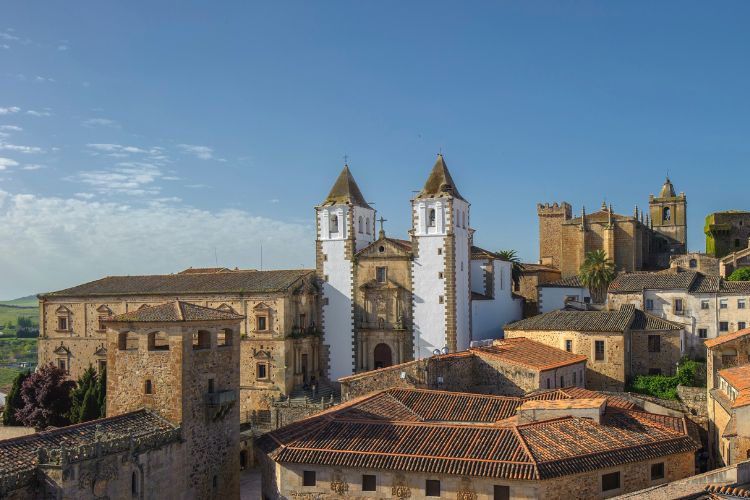
The enchanting hilltop town of Cáceres, a UNESCO World Heritage site since 1966, is a good place to begin your tour of Extremadura, Join an organized tour or wander your way aimlessly through cobbled streets past Renaissance palaces, churches and colorful squares to find gems like a brass monkey hanging from a wall on Calle Del Mono, which depicts a sad story from centuries ago of a jealous pet monkey who tossed a newborn baby out into the street.
Inside a side door of the Iglesia de la Preciosa Sangre, enjoy colorful costumes worn during the city’s elaborate Easter Week parades. You’ll also find tasty cookies and pastries baked by cloistered nuns at the Convent San Pablo. You’ll never see the nuns—both the money and pastries are transferred through a turntable on the wall.
Guided tours offer historical tidbits like an explanation of why one castle’s tower is so much taller than the others — Queen Isabella ordered all the towers of the others to be shortened because she wasn’t satisfied with the loyalty to the crown of the nobility living in them.
Càceres was the site of several scenes in “Game of Thrones” as the entry point to King’s Landing. You especially might recognize the city’s main gate, which played an important role during filming.
When you’re finished with your tour, ask to be directed to the hard-to-see stairs ascending the city’s medieval walls and take a stroll enjoying highlights like the 12th-century Bojaco Tower. By all means, don’t sit in your hotel during the evening since the city’s medieval skylight is entirely illuminated.
Read More: 10 Things to Do in Menorca, Spain: Mallorca’s Quieter Little Sister
Mérida
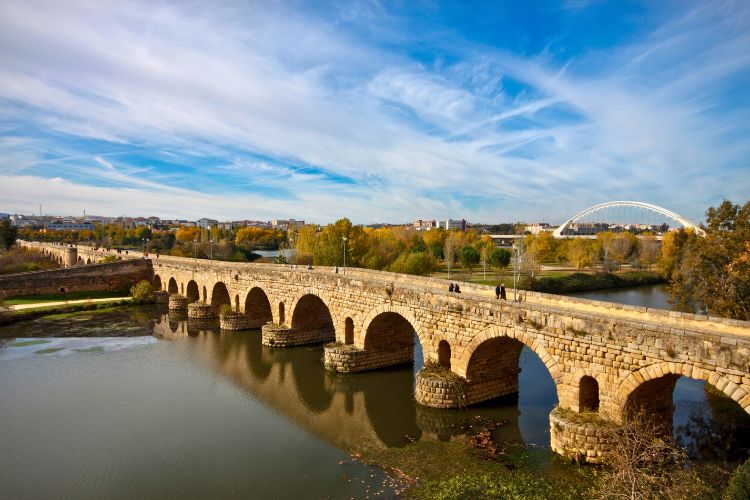
Just 60 miles south of Cáceres, the city of Mérida, a UNESCO World Heritage site since 1983, is one of the principal places to enjoy spectacular Roman ruins in all of Spain.
Founded in the first century BCE by Emperor Augustus to serve as the capital of the Roman province of Lusitania, its astounding architecture shows how the Romans went all out for the cities they designated as their capitals.
The city’s impressive Roman theater features two sets of arches facing semi-circular seating where spectators still enjoy live productions during the International Classical Theater Festival each July and August.
Nearby, the sizable amphitheater was the site of gladiator fights. And even though the locals still refer to the city’s still-beautiful temple as “The Temple of Diana,” it was actually dedicated to the imperial cult of the Roman Empire.
Los Milagros Aqueduct
Also impressive is the Los Milagros Aqueduct, with three tiers of arches 82 feet high, and the Puente Romano Bridge passing overtop the Guadiana River and consisting of 64 graceful arches, making it the longest surviving Roman bridge in Europe.
You’ll need at least half a day to visit the modern-day architectural gem of the National Museum of Roman Art, overflowing with Roman statuary and reliefs, mosaics, tombstones, glassware and coins.
Mérida so reveres its Roman heritage that it’s left a fallen pillar in the middle of one of its busy downtown streets — Traffic still swirls around it each day.
Termas Aqua Libera
Continue with the Roman theme at a place called Termas Aqua Libera in the nearby town of Aljucén, where you can enjoy an authentic “toga party” and eat a typical Roman meal collected from centuries-old cookbooks.
Meal items can either be eaten while seated around a table or by reclining around a little pool with the food passed back and forth in little boats.
Spa Treatment in Alange
And at the town of Alange, you can enjoy a Roman spa treatment that has been operating in this setting since the third century CE.
In some places, you’ll be enjoying massages, exfoliations, wraps and of course hot baths in two circular pools the Romans built so many centuries ago. In many cases, you’ll be treading on the very stones where the Romans themselves once walked.
Guadalupe
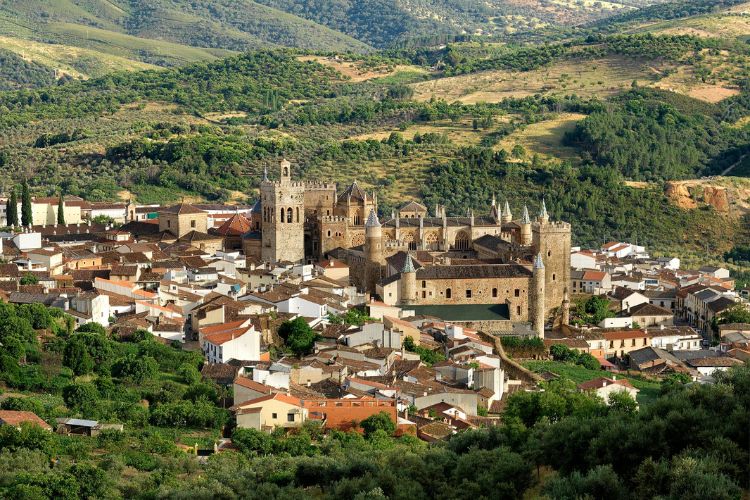
On a hilltop in a mountainous region in eastern Extremadura, the small town of Guadalupe is dwarfed by the gargantuan Royal Monastery of Guadalupe, with fortified walls of great height that are adorned with bell towers with conical tops and other architectural ornamentations.
A UNESCO World Heritage site since 1963, the monastery was erected atop a place where the Virgin directed a shepherd to find a small statue of her likeness. Construction began in 1340 and lasted well over three centuries, with elements of Gothic, Renaissance, Baroque, and Neoclassical architecture all woven into the huge complex.
Of historical significance, Guadalupe was the place where Queen Isabella met with Christopher Columbus before his first voyage to the New World and also met with him upon his return.
A Place of Pilgrimage
It’s now a place of pilgrimage for the thousands of religious pilgrims visiting each year who also take a look at the landscaped cloisters and museums of sculpture and art, including works by El Greco and Goya
But the highlight of the visit for the many religious pilgrims who make their way to the small town is a viewing of the statue of the Virgin. It’s only two feet high and one of only a handful of Black Madonnas in Spain, almost completely studded with precious gems embedded inside a brocade vestment stitched in gold.
My own visit here on my first trip to Spain in 2013 almost ended with no viewing of this Madonna. An extremely zealous priest initially refused to lift the screen obscuring the Virgin, because he felt our group, a collection of travel writers, lacked sufficient religious conviction to see something so precious. I’m so glad he relented!
Trujillo
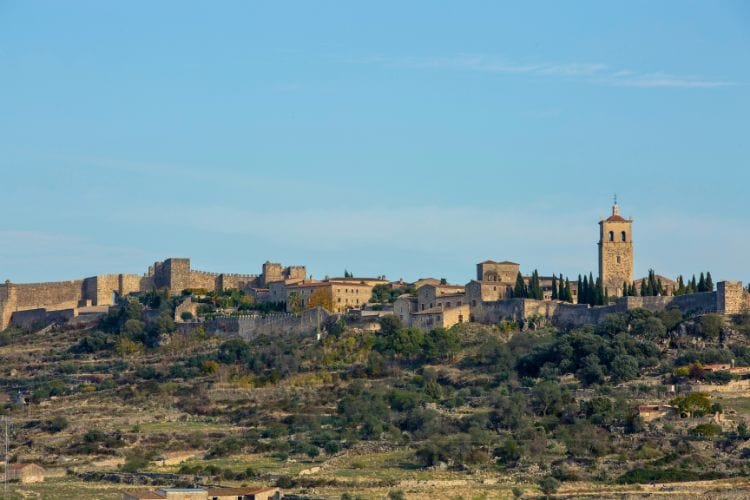
By now you may be thinking you’re spending too much time in Exremadura’s hill towns, but you absolutely need to see my personal favorite — Trujillo. It was founded by the Romans, but other cultures—the Visigoths, the Muslims, the Jews and the Christians have all left their mark.
As in Cáceres, monumental architecture from all those periods can still be seen on walking tours. But unlike Cáceres, which has relatively few residents remaining in its medieval core, Trujillo, is filled with Spanish people living their lives, — people walking their dogs, women going shopping, and children playing in schoolyards, all showing what a lively mix of people live there.
Read More: Spain Travel: Top 16 Attractions & Things to Do in Spain
Plaza Mayor and the Statue of Pizarro
You’ll likely begin your tour of Trujillo at the Plaza Mayor, the large central square at the city’s center. This central square is surrounded by magnificent Renaissance homes of nobles, whose owners were clearly competing with their neighbors for sheer opulence. The focal point of the square, however, is a huge bronze statue of Francisco Pizarro on horseback atop a high pedestal.
You may remember Pizarro from the history books as the merciless conqueror of Peru, attacking and obliterating the ancient Incas during his time there.
In spite of his not-so-stellar reputation, I’m particularly fond of this statue, largely, I think because of the multiple, goofy fronds erupting from his headpiece. I chuckle to myself every time I look at it. Pizarro was a native of Trujillo— the house of his birth is now a museum focusing on his life.
Castillo of Trujillo
My favorite part of a visit to Trujillo, however, is a walk through the city up its steep hills to reach the Castillo (Castle) of Trujillo dating from the 13th century and situated at the city’s highest point.
The castle’s ornamentation, both inside and out, is rather spartan but the true highlight of your visit here will be a grand promenade along the castle’s upper walls, where you’ll take in an extraordinary view of the city’s beautiful surroundings with vistas of hills.
There are even high mountains on the horizon and pasturelands and farmer’s fields sweeping in on all sides. I assure you, this is one Spanish hilltop town you won’t want to miss.
Extremadura’s Landscape

By no means should you limit your exploration of Extremadura to these four cities, as magnificent as they are. Be sure to allow time to get out in the countryside to explore the varied topography.
Much of Extremadura’s 16,000 square miles is flat, but there are also high mountains, especially at Monfragüe National Park in the north where jagged peaks, cliffs and rock formations can be found along with dense oak woodlands.
A distinctive feature of the Extremadura landscape is what the Spanish call the “dehesa,” the mostly flat pastureland that’s been deliberately studded with oak trees, the acorns of which serve as the principal diet of “pampered pigs,” (more on that in a minute).
And with approximately 1,500 miles of internal coastline found in Extremadura’s lakes and rivers, there are ample opportunities for swimming, boating, fishing, and so on.
Other Small Towns to Visit
And while you’re exploring the countryside, stop in at one of these quaint small towns you may pass along the way:
- Plascencia —With a porticoed main square, this charming town also has both an “Old” Romanesque” cathedral, alongside a “new” Gothic one.
- Hervàs — has a lovely old Jewish quarter
- Medellín —The birthplace of Hernán Cortez, conquerer of the Aztecs in Mexico, with a grim fortress on a hilltop overlooking the town.
- Jerez de los Caballeros — This town is remarkable for its skyline of many churches. The best place to see all of them is along the highway bypass just outside of the town.
- Zafra — Sometimes referred to as “Little Seville,” Zafra has both a Plaza Grande and Plaza Chica. The town’s foreboding fortress has been transformed into a comfortable hotel (See accommodations)’
Birdwatching and Dark Skies

Extremadura is known as a birdwatching paradise, one of the best in all of Europe, with the region overlapping two major migration flyways. A total of 360 separate species have been spotted with about 280 of them resident year-round.
It’s become a mecca for birdwatchers to add to their “Life List,’ spotting species such as the black vulture, the Spanish imperial eagle, the black stork, the lesser kestrel, and the great bustard.
A number of professional birdwatchers are available for hire for bespoke private tours or for group tours.
One birding area that shouldn’t be missed is Las Barruecos National Monument, about 15 minutes outside of Càceres, and a place of great scenic beauty — you’ll be stunned by the gigantic rock formations, often piled one on top of another and with unusual shapes.
“Game of Thrones” filmed a crucial battle scene here with computer-generated armies swarming over these rocks. And just picture what a fire-breathing dragon would look like flying overhead and taking aim at its enemies. Then watch the filmed version to see how this landscape was transformed.
Entre Encinas y Estrellas Resort
Also, because of its remoteness and distance from large cities, much of Extremadura receives a “Dark Sky” designation, meaning that world-class stargazing, either with telescopes or even just the naked eye, can take place.
We stayed at a wondrous place called Entre Encinas y Estrellas (Between the Oaks and the Stars), a resort of several spacious cabins built around kind of a stargazing theme park, where astronomers from around the world rent space for their telescopes.
For novices, nightly sky gazing seminars are offered under the open sky if weather permits or inside an observatory that appears to be a huge replica of R2D2 from “Star Wars.”
With our naked eyes we could see the Milky Way in its entirety stretching across the sky above us, and with the aid of telescopes, we saw craters on the moon and even the rings of Saturn.
Read More: Experiencing Spain’s Olive Oil Culture, Grove to Table
Food and Wine in Extremadura

The extraordinary agricultural abundance in Extremadura makes for a similarly extraordinary dining experience for visitors.
Principal among the must-tries of the region is jamón ibérico, (Iberian ham), produced by the black Iberian pigs you’ll see grazing all over the region who wander through the Dehesa feeding on grass and herbs but also substantially on the abundant acorns falling from the many oak trees — It’s the pigs’ consumption of all these acorns that account for the unique flavors of the ham.
You’ll find jamón ibérico served throughout Spain, but its origin point is Extremadura, where it’s routinely offered in every restaurant, sometimes without your asking for it, in the form of a tray of thin slices, sometimes pounded so flat they’re almost see-through. Savor the marbles of fat in each piece — that’s where much of the unique flavor is.
Many different cheeses are also produced in Extremadura but the one distinctive to the region is Torta del Casa, a cheese made with sheep’s milk with an intense creaminess and rich flavor. If it’s to your liking, you may find yourself spooning large quantities into your mouth.
Smoked Paprika in Extremadura

My very favorite food item originating from Extremadura, however, is the distinctive smoked paprika produced here using peppers that were originally brought back from the New World, which nowadays are smoked over oak wood fires and hand-turned for 10 to 15 days before being ground into paprika.
You can find the paprika in three different flavors — sweet, bittersweet, and spicy — and tins of all three flavors are easily found in many shops—I recommend taking several home for use in your own kitchen. Whenever I serve chicken paprikash using this unique paprika, my guests invariably swoon with delight. As do I.
Wines of Extremadura
The wines of Extremadura, although not as well known as in other regions such as Rioja or Ribera del Duero, are still quite flavorful, produced mostly by strict standards governing the local Ribera Guadiana Denominación de Origen.
Our winery stops included places as diverse as Habla outside of Trujillo, one of the largest wineries in Spain, a sleek modern facility where we sipped one-of-a-kind wines never produced before and never to be produced again.
We also stopped at a small facility producing organic wines, some of them aged in small earthenware vessels and amphoras using techniques dating from the earliest days of winemaking.
Accommodation Options in Extremadura

You’ll find a broad range of hotels throughout Extremadura, but I’d especially like to recommend a chain of hotels found throughout Spain called “paradores,” which are housed inside historic buildings like castles or palaces, monasteries or convents, or centuries-old fortresses.
Extremadura is especially blessed with seven paradores at Cáceres, Mérida, Trujillo, Guadalupe, Plasencia, Jarandilla, and Zafra. In fact, many of these are designated as four-star hotels with each one having an on-site restaurant serving regional and local cuisine.
The comfortable and sizable rooms have historic-looking furniture to add to the ambiance. I can especially recommend the Parador at Mérida, a former 14th-century palace and later a monastery, that’s centrally located near the city center.
A bonus: There are two ghosts here, one a young boy who mischievously knocks on people’s doors, then disappears, and a monk, who strolls the hallways in his monk’s outfit. I didn’t see either one but enjoyed knowing they were there.
If You Go:
For more comprehensive information on Extremadura’s many wonders, go to the region’s website. Extensive information on tourist destinations throughout Spain, including Extremadura, can also be found here.
Read More:
Author Bio: Ohio-based travel writer Rich Warren travels the country and the world looking for offbeat and off-the-beaten-path stories. He is a graduate of the Elf School of Reykjavik and can tell you what the Amish wear to the beach in Florida!

